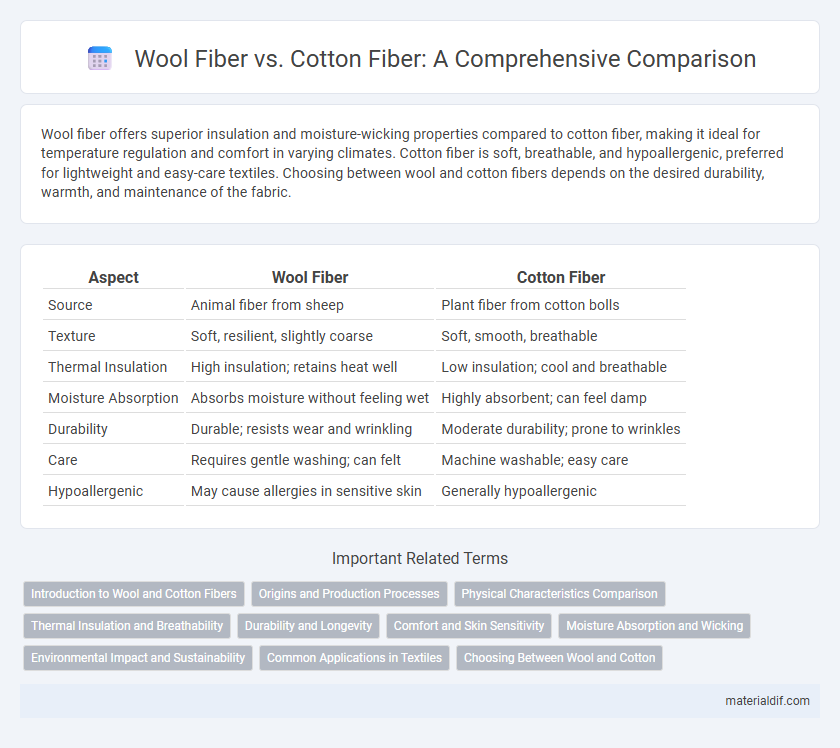Wool fiber offers superior insulation and moisture-wicking properties compared to cotton fiber, making it ideal for temperature regulation and comfort in varying climates. Cotton fiber is soft, breathable, and hypoallergenic, preferred for lightweight and easy-care textiles. Choosing between wool and cotton fibers depends on the desired durability, warmth, and maintenance of the fabric.
Table of Comparison
| Aspect | Wool Fiber | Cotton Fiber |
|---|---|---|
| Source | Animal fiber from sheep | Plant fiber from cotton bolls |
| Texture | Soft, resilient, slightly coarse | Soft, smooth, breathable |
| Thermal Insulation | High insulation; retains heat well | Low insulation; cool and breathable |
| Moisture Absorption | Absorbs moisture without feeling wet | Highly absorbent; can feel damp |
| Durability | Durable; resists wear and wrinkling | Moderate durability; prone to wrinkles |
| Care | Requires gentle washing; can felt | Machine washable; easy care |
| Hypoallergenic | May cause allergies in sensitive skin | Generally hypoallergenic |
Introduction to Wool and Cotton Fibers
Wool fiber, derived from the fleece of sheep, is a natural protein fiber known for its excellent insulation, elasticity, and moisture-wicking properties, making it ideal for cold-weather garments. Cotton fiber, sourced from the seed hairs of cotton plants, is a cellulose-based natural fiber prized for its breathability, softness, and durability, which suits warm climates and everyday apparel. Both fibers differ significantly in structure and performance, influencing their applications in textiles and fabric production.
Origins and Production Processes
Wool fiber originates from the fleece of sheep, primarily raised in regions such as Australia and New Zealand, where the production involves shearing, cleaning, and carding to prepare the fibers for spinning. Cotton fiber is derived from the seed hairs of the cotton plant, predominantly cultivated in countries like the United States, India, and China, undergoing harvesting, ginning, and combing processes to separate and refine the fibers. Wool production relies on animal husbandry and seasonal shearing cycles, while cotton production depends on agricultural cultivation and mechanical harvesting techniques.
Physical Characteristics Comparison
Wool fiber features a natural crimp and scales, providing elasticity, insulation, and moisture-wicking properties, whereas cotton fiber is smooth, with a flat, twisted ribbon-like structure, making it breathable and soft but less elastic. Wool's loft and resilience lead to superior warmth retention and durability compared to the more absorbent and cooler cotton fibers. The physical differences contribute to wool's suitability for cold weather garments and cotton's preference for lightweight, breathable fabrics.
Thermal Insulation and Breathability
Wool fiber exhibits superior thermal insulation due to its natural crimp, which traps heat and maintains warmth even when damp, making it highly effective in cold climates. Cotton fiber, while breathable and comfortable for warm weather, lacks the insulating properties of wool and tends to retain moisture, reducing its thermal efficiency. The unique structure of wool fibers enhances moisture-wicking and temperature regulation, whereas cotton fibers prioritize softness and airflow.
Durability and Longevity
Wool fiber exhibits superior durability due to its natural elasticity and resilience, allowing it to withstand frequent bending and stretching without damage. Cotton fiber, while soft and breathable, tends to weaken with repeated washing and friction, resulting in shorter lifespan compared to wool. The inherent moisture-wicking and anti-microbial properties of wool also contribute to its extended longevity in various textile applications.
Comfort and Skin Sensitivity
Wool fiber offers excellent insulation and moisture-wicking properties, making it comfortable in both cold and warm conditions, while its natural lanolin content provides a soft feel that can reduce skin irritation. Cotton fiber is highly breathable and hypoallergenic, ideal for sensitive skin due to its smooth texture and ability to absorb moisture without causing itchiness. Both fibers excel in comfort, but cotton is often preferred for delicate skin, whereas wool is favored for temperature regulation and durability.
Moisture Absorption and Wicking
Wool fiber exhibits superior moisture absorption, capable of absorbing up to 30% of its weight in moisture without feeling damp, unlike cotton fiber which absorbs less and dries slower. Wool's natural crimp and scale structure enhance moisture wicking by moving sweat away from the skin to the fabric surface where it evaporates efficiently. Cotton fiber tends to retain moisture within its structure, leading to prolonged dampness and slower drying times compared to wool.
Environmental Impact and Sustainability
Wool fiber, derived from sheep, is biodegradable and renewable, offering natural insulation properties that reduce energy consumption in textile production. Cotton fiber cultivation demands significant water usage and pesticides, contributing to soil degradation and environmental pollution. Sustainable farming practices for both fibers are improving, but wool typically presents a lower overall environmental footprint than conventional cotton.
Common Applications in Textiles
Wool fiber is commonly used in warm clothing such as sweaters, coats, and blankets due to its excellent insulation and moisture-wicking properties. Cotton fiber is widely favored for breathable, lightweight garments like t-shirts, underwear, and summer dresses, as well as home textiles such as bed linens and towels. Both fibers find extensive use in upholstery and textile blends, enhancing comfort and durability in everyday products.
Choosing Between Wool and Cotton
Choosing between wool and cotton fibers depends on the intended use, climate, and desired properties of the fabric. Wool fiber excels in insulation and moisture-wicking, making it ideal for cold-weather clothing and outdoor gear, while cotton fiber offers breathability and softness suited for warmer climates and everyday wear. Evaluating factors like durability, texture, and care requirements ensures the best selection between wool and cotton for specific textile applications.
Wool Fiber vs Cotton Fiber Infographic

 materialdif.com
materialdif.com